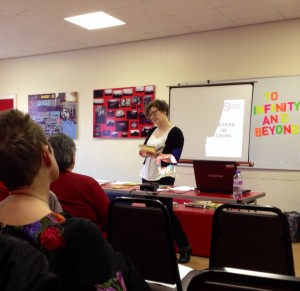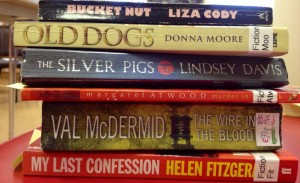On Wednesday 5th March, I joined Morag Smith (National Lifelong Learning Development Worker at Glasgow Women’s Library) at the ‘Sisters in Crime’ session at Menzieshill Community Centre, Dundee. Part of Dundee Women’s Festival 2014, this session gave participants the opportunity to share their favourite crime stories and writers, discover new authors and to find out more about the selection of women’s crime writing available on the GWL shelves.
Morag began the session with an introduction to Glasgow Women’s Library and what it has to offer, pointing out that as well as providing all the services of a lending library, GWL also holds a unique archive of feminist and lesbian magazines, oral histories and objects of historical significance, while also offering a comprehensive and varied calendar of events, activities and training. Her mini-quiz, which included questions about the number of statues of women in Glasgow and the foundation dates of women’s suffrage in various countries, also illustrated the relevance of (and need for) a women’s library in 2014.
We began by splitting into pairs to discuss our favourite female crime writers and their work. The question of what constitutes the ‘perfect murder’ provided a great talking point, with suggestions including accidents on clandestine boat trips, poisoning, crossbows armed with arrows of ice and frozen chickens! It also opened up a fascinating discussion about perceptions of female killers as opposed to their male equivalents, and whether we instinctively attribute methods of murder which are more insidious and less explicitly violent to females, and so to our female characters.
Our list of favourite crime writers threw up some prominent names including Val McDermid and Gillian Flynn, and I’ve also added some authors to my own ‘to-read’ list (I’ll certainly be tracking down books by Tess Gerritsen, Gladys Mitchell and Kate Tremayne, among others). As we discussed what we look for in our crime writing (several members of the group felt that there is such a thing as ‘too gruesome’) we also touched briefly upon adaptations of crime writing for TV and film, and found that on-screen renderings of much-loved stories can be very controversial!

Morag then took us on a whistle-stop tour of women’s crime writing, and read extracts from some of the books which can be found on the shelves at GWL. We heard an extract from Val McDermid’s Wire in the Blood, and also Making Poison by Margaret Atwood. Making Poison is a very short story which illustrates a childlike fascination with the macabre; we had briefly discussed why it is that we have the urge to read and write crime, and this story really offered an interesting perspective on this. Morag also pointed out that Margaret Atwood is not known for crime writing, and that some of the most evocative and artful writing in the genre can often come from writers for whom it isn’t a known speciality.
Finally, we discovered that women have been writing crime for longer than we might think, with examples like Nora Van Snoop in Harmsworth Magazine dating to the mid-nineteenth century. This and further examples all fed into a discussion about how women in crime writing (writers and characters) are defined, and the parameters within which they operate. Broadly speaking, it seems that much of the earlier crime writing defines female characters as amateur sleuths or femmes fatales. However, the genre has grown up, and the tough policewomen, forensic scientists and technical professionals on the front line dealing with gruesome violence are exemplified by characters from writers like Val McDermid and Liza Cody. Women writers have employed the crime genre as a means to challenge stereotypes of femininity and to place female characters into roles which were traditionally held to be masculine, and the result has been to make crime writing far richer and a great deal more original.
We had a great time at Menzieshill Community Centre, and our sincere thanks go to all of the women who came along to the session for their participation and enthusiasm – we hope that you enjoyed the discussions as much as we did!
Glasgow Women’s Library offers a broad selection of women’s crime writing, as well as reading groups, projects and creative writing support. If you’d like to get involved, visit GWL at 23 Landressy Street, Bridgeton, Glasgow G40 1BP or check the catalogue here.
Rebecca Jones


Comments are closed.